斯坦福卫生经济学教材(Health Economics)杰伊·巴塔查里亚《健康经济学》课程教学资源(PPT课件,英文版)Chapter 16 THE BEVERIDGE MODEL - NATIONALIZED HEALTH CARE
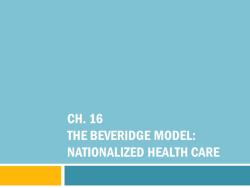
CH.16 THE BEVERIDGE MODEL: NATIONALIZED HEALTH CARE
CH. 16 THE BEVERIDGE MODEL: NATIONALIZED HEALTH CARE

The Beveridge Plan UK:National Health Services Bill of 1946 Based on a plan by economist William Beveridge focused on shared sacrifice and national solidarity Beveridge Model has three defining features Universal,single-payer insurance Public health care provision ▣Free care Bhattacharya,Hyde and Tu-HealthEconomics
Bhattacharya, Hyde and Tu – Health Economics The Beveridge Plan UK: National Health Services Bill of 1946 Based on a plan by economist William Beveridge focused on shared sacrifice and national solidarity Beveridge Model has three defining features Universal, single-payer insurance Public health care provision Free care
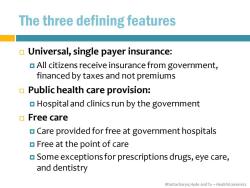
The three defining features Universal,single payer insurance: All citizens receive insurance from government, financed by taxes and not premiums Public health care provision: Hospital and clinics run by the government Free care Care provided for free at government hospitals Free at the point of care Some exceptions for prescriptions drugs,eye care, and dentistry Bhattacharya,Hyde and Tu-HealthEconomics
Bhattacharya, Hyde and Tu – Health Economics The three defining features Universal, single payer insurance: All citizens receive insurance from government, financed by taxes and not premiums Public health care provision: Hospital and clinics run by the government Free care Care provided for free at government hospitals Free at the point of care Some exceptions for prescriptions drugs, eye care, and dentistry
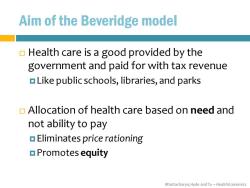
Aim of the Beveridge model Health care is a good provided by the government and paid for with tax revenue Like public schools,libraries,and parks Allocation of health care based on need and not ability to pay Eliminates price rationing Promotes equity Bhattacharya,Hyde and Tu-HealthEconomics
Bhattacharya, Hyde and Tu – Health Economics Aim of the Beveridge model Health care is a good provided by the government and paid for with tax revenue Like public schools, libraries, and parks Allocation of health care based on need and not ability to pay Eliminates price rationing Promotes equity
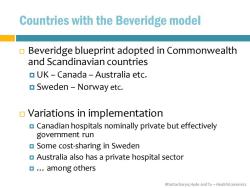
Countries with the Beveridge model Beveridge blueprint adopted in Commonwealth and Scandinavian countries UK-Canada-Australia etc. Sweden-Norway etc. Variations in implementation Canadian hospitals nominally private but effectively government run Some cost-sharing in Sweden Australia also has a private hospital sector ▣..among others Bhattacharya,Hyde and Tu-HealthEconomics
Bhattacharya, Hyde and Tu – Health Economics Countries with the Beveridge model Beveridge blueprint adopted in Commonwealth and Scandinavian countries UK – Canada – Australia etc. Sweden – Norway etc. Variations in implementation Canadian hospitals nominally private but effectively government run Some cost-sharing in Sweden Australia also has a private hospital sector … among others
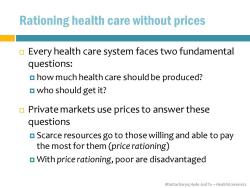
Rationing health care without prices Every health care system faces two fundamental questions: how much health care should be produced? ▣who should get it? Private markets use prices to answer these questions Scarce resources go to those willing and able to pay the most for them (price rationing) With price rationing,poor are disadvantaged Bhattacharya,Hyde and Tu-HealthEconomics
Bhattacharya, Hyde and Tu – Health Economics Rationing health care without prices Every health care system faces two fundamental questions: how much health care should be produced? who should get it? Private markets use prices to answer these questions Scarce resources go to those willing and able to pay the most for them (price rationing) With price rationing, poor are disadvantaged
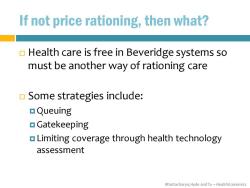
If not price rationing,then what? Health care is free in Beveridge systems so must be another way of rationing care Some strategies include: Queuing Gatekeeping Limiting coverage through health technology assessment Bhattacharya,Hyde and Tu-HealthEconomics
Bhattacharya, Hyde and Tu – Health Economics If not price rationing, then what? Health care is free in Beveridge systems so must be another way of rationing care Some strategies include: Queuing Gatekeeping Limiting coverage through health technology assessment
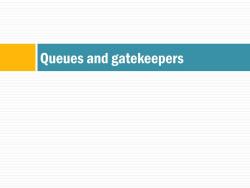
Queues and gatekeepers
Queues and gatekeepers

Why do queues arise? Because Beveridge governments mandate free (or very-low cost)care Demand can be high In private markets,physician and nurse salaries increase so that supply matches demand In Beveridge systems,salaries set by government so market cannot equilibrate High demand and low supply results in queues Bhattacharya,Hyde and Tu-HealthEconomics
Bhattacharya, Hyde and Tu – Health Economics Why do queues arise? Because Beveridge governments mandate free (or very-low cost) care Demand can be high In private markets, physician and nurse salaries increase so that supply matches demand In Beveridge systems, salaries set by government so market cannot equilibrate High demand and low supply results in queues
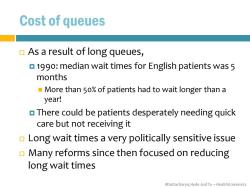
Cost of queues As a result of long queues, 1990:median wait times for English patients was 5 months More than 50%of patients had to wait longer than a year! There could be patients desperately needing quick care but not receiving it Long wait times a very politically sensitive issue Many reforms since then focused on reducing long wait times Bhattacharya,Hyde and Tu-HealthEconomics
Bhattacharya, Hyde and Tu – Health Economics Cost of queues As a result of long queues, 1990: median wait times for English patients was 5 months ◼ More than 50% of patients had to wait longer than a year! There could be patients desperately needing quick care but not receiving it Long wait times a very politically sensitive issue Many reforms since then focused on reducing long wait times
按次数下载不扣除下载券;
注册用户24小时内重复下载只扣除一次;
顺序:VIP每日次数-->可用次数-->下载券;
- 斯坦福卫生经济学教材(Health Economics)杰伊·巴塔查里亚《健康经济学》课程教学资源(PPT课件,英文版)Chapter 15 THE HEALTH POLICY CONUNDRUM.ppt
- 斯坦福卫生经济学教材(Health Economics)杰伊·巴塔查里亚《健康经济学》课程教学资源(PPT课件,英文版)Chapter 14 HEALTH TECHNOLOGY ASSESSMENT.ppt
- 斯坦福卫生经济学教材(Health Economics)杰伊·巴塔查里亚《健康经济学》课程教学资源(PPT课件,英文版)Chapter 13 TECHNOLOGY AND THE PRICE OF HEALTH CARE.ppt
- 斯坦福卫生经济学教材(Health Economics)杰伊·巴塔查里亚《健康经济学》课程教学资源(PPT课件,英文版)Chapter 12 PHARMACEUTICALS AND THE ECONOMICS OF INNOVATION.ppt
- 斯坦福卫生经济学教材(Health Economics)杰伊·巴塔查里亚《健康经济学》课程教学资源(PPT课件,英文版)Chapter 11 MORAL HAZARD.ppt
- 斯坦福卫生经济学教材(Health Economics)杰伊·巴塔查里亚《健康经济学》课程教学资源(PPT课件,英文版)Chapter 10 ADVERSE SELECTION IN REAL MARKETS.ppt
- 斯坦福卫生经济学教材(Health Economics)杰伊·巴塔查里亚《健康经济学》课程教学资源(PPT课件,英文版)Chapter 01 WHY HEALTH ECONOMICS?.ppt
- 斯坦福卫生经济学教材(Health Economics)杰伊·巴塔查里亚《健康经济学》课程教学资源(试卷习题,英文版)课后判断题及答案 Ch 9 Adverse Selection - The Rothschild-Stiglitz Model.pdf
- 斯坦福卫生经济学教材(Health Economics)杰伊·巴塔查里亚《健康经济学》课程教学资源(试卷习题,英文版)课后判断题及答案 Ch 8 Adverse Selection - Akerlof’s Market for Lemons.pdf
- 斯坦福卫生经济学教材(Health Economics)杰伊·巴塔查里亚《健康经济学》课程教学资源(试卷习题,英文版)课后判断题及答案 Ch 7 Demand for Insurance.pdf
- 斯坦福卫生经济学教材(Health Economics)杰伊·巴塔查里亚《健康经济学》课程教学资源(试卷习题,英文版)课后判断题及答案 Ch 6 The Hospital Industry.pdf
- 斯坦福卫生经济学教材(Health Economics)杰伊·巴塔查里亚《健康经济学》课程教学资源(试卷习题,英文版)课后判断题及答案 Ch 5 The Labor Market for Physicians.pdf
- 斯坦福卫生经济学教材(Health Economics)杰伊·巴塔查里亚《健康经济学》课程教学资源(试卷习题,英文版)课后判断题及答案 Ch 4 Socioeconomic Disparities in Health.pdf
- 斯坦福卫生经济学教材(Health Economics)杰伊·巴塔查里亚《健康经济学》课程教学资源(试卷习题,英文版)课后判断题及答案 Ch 3 Demand for Health:The Grossman Model.pdf
- 斯坦福卫生经济学教材(Health Economics)杰伊·巴塔查里亚《健康经济学》课程教学资源(试卷习题,英文版)课后判断题及答案 Ch 24 Time Inconsistency and Health.pdf
- 斯坦福卫生经济学教材(Health Economics)杰伊·巴塔查里亚《健康经济学》课程教学资源(试卷习题,英文版)课后判断题及答案 Ch 23 Prospect Theory.pdf
- 斯坦福卫生经济学教材(Health Economics)杰伊·巴塔查里亚《健康经济学》课程教学资源(试卷习题,英文版)课后判断题及答案 Ch 22 Obesity.pdf
- 斯坦福卫生经济学教材(Health Economics)杰伊·巴塔查里亚《健康经济学》课程教学资源(试卷习题,英文版)课后判断题及答案 Ch 21 Economic Epidemiology.pdf
- 斯坦福卫生经济学教材(Health Economics)杰伊·巴塔查里亚《健康经济学》课程教学资源(试卷习题,英文版)课后判断题及答案 Ch 20 The Economics of Health Externalities.pdf
- 斯坦福卫生经济学教材(Health Economics)杰伊·巴塔查里亚《健康经济学》课程教学资源(试卷习题,英文版)课后判断题及答案 Ch 2 Demand for Health Care.pdf
- 斯坦福卫生经济学教材(Health Economics)杰伊·巴塔查里亚《健康经济学》课程教学资源(PPT课件,英文版)Chapter 17 THE BISMARCK MODEL - SOCIAL HEALTH INSURANCE.ppt
- 斯坦福卫生经济学教材(Health Economics)杰伊·巴塔查里亚《健康经济学》课程教学资源(PPT课件,英文版)Chapter 18 THE AMERICAN MODEL.ppt
- 斯坦福卫生经济学教材(Health Economics)杰伊·巴塔查里亚《健康经济学》课程教学资源(PPT课件,英文版)Chapter 19 POPULATION AGING AND THE FUTURE OF HEALTH POLICY.ppt
- 斯坦福卫生经济学教材(Health Economics)杰伊·巴塔查里亚《健康经济学》课程教学资源(PPT课件,英文版)Chapter 02 DEMAND FOR HEALTH CARE.ppt
- 斯坦福卫生经济学教材(Health Economics)杰伊·巴塔查里亚《健康经济学》课程教学资源(PPT课件,英文版)Chapter 20 THE ECONOMICS OF HEALTH EXTERNALITIES.ppt
- 斯坦福卫生经济学教材(Health Economics)杰伊·巴塔查里亚《健康经济学》课程教学资源(PPT课件,英文版)Chapter 21 ECONOMIC EPIDEMIOLOGY.ppt
- 斯坦福卫生经济学教材(Health Economics)杰伊·巴塔查里亚《健康经济学》课程教学资源(PPT课件,英文版)Chapter 22 OBESITY.ppt
- 斯坦福卫生经济学教材(Health Economics)杰伊·巴塔查里亚《健康经济学》课程教学资源(PPT课件,英文版)Chapter 23 PROSPECT THEORY.ppt
- 斯坦福卫生经济学教材(Health Economics)杰伊·巴塔查里亚《健康经济学》课程教学资源(PPT课件,英文版)Chapter 24 TIME INCONSISTENCY AND HEALTH.ppt
- 斯坦福卫生经济学教材(Health Economics)杰伊·巴塔查里亚《健康经济学》课程教学资源(PPT课件,英文版)Chapter 03 CHAPTER 3 DEMAND FOR HEALTH:THE GROSSMAN MODEL.ppt
- 斯坦福卫生经济学教材(Health Economics)杰伊·巴塔查里亚《健康经济学》课程教学资源(PPT课件,英文版)Chapter 04 SOCIOECONOMIC DISPARITIES IN HEALTH.ppt
- 斯坦福卫生经济学教材(Health Economics)杰伊·巴塔查里亚《健康经济学》课程教学资源(PPT课件,英文版)Chapter 05 THE PHYSICIAN LABOR MARKET.ppt
- 斯坦福卫生经济学教材(Health Economics)杰伊·巴塔查里亚《健康经济学》课程教学资源(PPT课件,英文版)Chapter 06 THE HOSPITAL INDUSTRY.ppt
- 斯坦福卫生经济学教材(Health Economics)杰伊·巴塔查里亚《健康经济学》课程教学资源(PPT课件,英文版)Chapter 07 DEMAND FOR INSURANCE.ppt
- 斯坦福卫生经济学教材(Health Economics)杰伊·巴塔查里亚《健康经济学》课程教学资源(PPT课件,英文版)Chapter 08 ADVERSE SELECTION - AKERLOF’S MARKET FOR LEMONS.ppt
- 斯坦福卫生经济学教材(Health Economics)杰伊·巴塔查里亚《健康经济学》课程教学资源(PPT课件,英文版)Chapter 09 ADVERSE SELECTION - THE ROTHSCHILD-STIGLITZ MODEL.ppt
- 兰州交通大学:《微观经济学》课程教学资源(教案大纲)教学大纲 Microeconomics(负责人:李新文).pdf
- 兰州交通大学:《微观经济学》课程教学资源(教案大纲)微观经济学授课教案(打印版).pdf
- 兰州交通大学:《微观经济学》课程教学资源(案例分析)微观经济学教学案例(打印版).pdf
- 《微观经济学》课程教学资源(书籍文献)西方经济学名著选读.pdf
